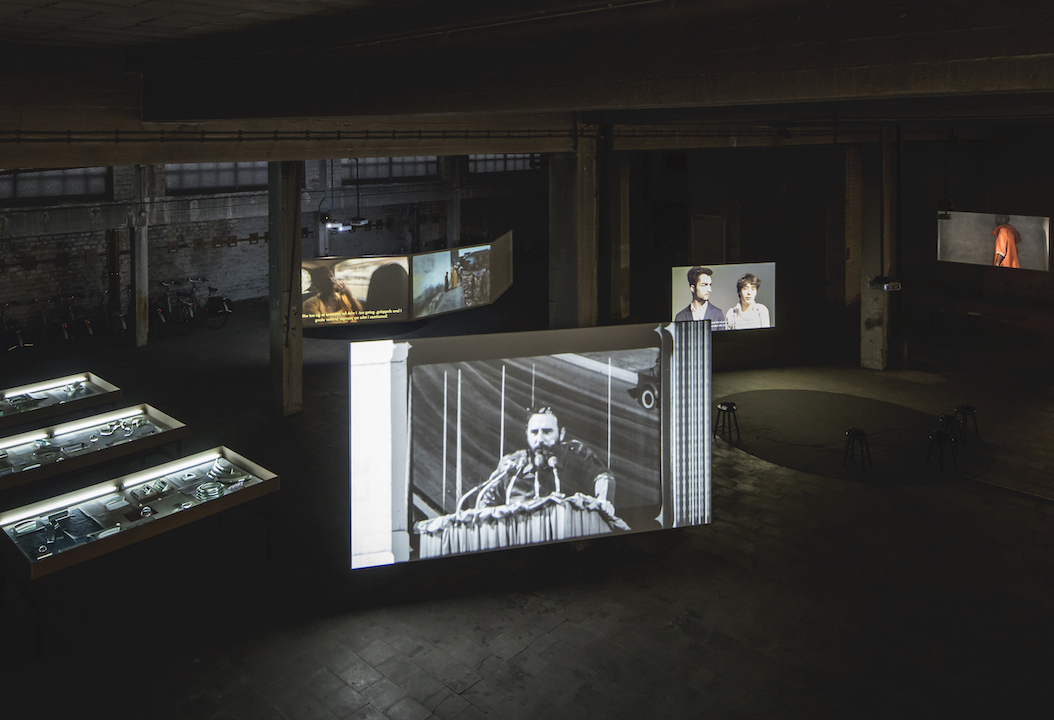SYLVIE FORTIN
Sweet Dreams (Are Made of This)
- 17.12.2018
Shilpa Gupta, WheredoIendandyoubegin, 2012 LED-based light installation. 880 x 68 cm. Produced with the support of “Mixed Bathing World,” Beppu, Japan. Installation view GIBCA 2017 WheredoIendandyoubegin On Secularity. Photo: Hendrik Zeitler
Two years ago, the membership of International Biennial Association (IBA) resolved to support the development of an exciting new public programme: an annual publication that would both bear witness to and intervene in the evolution of biennials. In keeping with the Association’s ethos, we invited members wishing to contribute to this initiative to come forward. A volunteer six-member editorial committee was formed, bringing a diversity of views, experiences and motivations to the project, as well as solid publishing expertise. The steadfast support, commitment and enthusiasm of my fellow editorial committee members Anne Barlow, Bige Örer and Başak Şenova have been a boundless source of energy and inspiration. The input of Lisa Howie and Nevenka Šivavec has also significantly shaped the project. I sincerely thank these amazing women and colleagues for their time, talent, intelligence, generosity and determination.
Shilpa Gupta, WheredoIendandyoubegin, 2012 LED-based light installation. 880 x 68 cm. Produced with the support of “Mixed Bathing World,” Beppu, Japan. Installation view GIBCA 2017 WheredoIendandyoubegin On Secularity. Photo: Hendrik Zeitler
This publication reflects the biennial field’s shared and acutely perceived need: a self-determined platform to consciously examine the biennial as an active, critical and evolving form, and a forum to define our own measures of accountability. Biennials often capture the imagination of social scientists and humanities scholars. Their cosmopolitan allure, local embeddedness and public engagement make biennials a darling subject of curatorial studies. As exhibition history takes its place in the art historical canon, biennials, which have long been privileged sites of experimentation, gain pride of place. We laud this attention while recognising that a crucial voice is still missing: the critical assessment of biennial makers. This publication seeks to fill that gap and to become the vehicle for biennial makers to share their knowledge and experience, to present their challenges and to chart ways ahead.
This annual publication aims to present the critical and experimental role of contemporary art biennials around the world. It presents diverse approaches and divergent perspectives on biennials as institutions, curatorial endeavours and public projects. It examines the biennial as an actively evolving form that mobilises relationships between artists, sites and audiences on varied scales and in different contexts. It explores the issues and challenges arising in the perennially shifting field of biennial making. It also aims to serve as a tool for learning, debate and advocacy while shaping the public profile of biennials.
Having defined our mission, we next faced the challenge of naming. We sought to find something short, intriguing, visual, polysemic and pleasing to the tongue. We came up with Pass, which, as both verb and noun, conveys action in all its multidirectedness. The word ‘pass’ evokes access and success, as well as refusal and withdrawal. It signals movement, transit, circulation, effort and evasion. In sports, it suggests collaboration and teamwork. In life, it announces desire, flirtation, playfulness, cunning and conviviality. Passing is also about defiance, mistake and misrecognition, a wilful straddling of categories in a rejection of norms. Pass is a tall order.
We hope that this inaugural issue of Pass measures up to this vision. We convened a multiplicity of voices: artists, curators, directors, founders and visitors – knowing that many of us often pass, and speak from several of these positions. As form and context matter, we juxtaposed conversations, essays, case studies and opinion pieces.
Throughout the issue, several authors point to the decisive role of artists in the development of the biennial field, as well as the influence of their ideas, projects and institutions. Bearing that in mind, Canadian artists Richard Ibghy and Marilou Lemmens set the tone for this publication with an essay exploring their experience with three biennials (Sharjah, Istanbul and Montreal), the impact of biennials on their work and the insights they have gained. For them, biennials are invaluable because “each one has been an occasion to think with others about the issues that preoccupy us most.”
Jochen Volz and Nav Haq present case studies that reflect their recent biennial curatorial experiences in São Paulo and Göteborg. We check in with Kitty Scott as she is getting ready for Liverpool and call on Gabriel Pérez Barreiro to assess the role of biennials as he is preparing his second biennial in Brazil. We turn to Athens and Kochi to consider biennials from the position of the organisers: a lucid take on the weight of institutional politics, the power of place and audience, and possible ways ahead.
Our conversations with Iara Boubnova, Gerardo Mosquera, Nevenka Šivavec and Adelina Cüberyan von Fürstenberg yield candid observations and unexpected turns. These interviews also constitute an archive that will become a significant resource for understanding the different stakes, histories and dynamics of biennial making. In her wide-ranging conversation, Boubnova identifies the main characteristics of biennials: they are producers and they connect people, while the brand name ‘biennial’ enjoys considerable political currency and carries expectations of internationalism. For her, the organisation of a biennial is a process of translation: it’s about tackling questions and difficulties that may not yet have proper translations, but for which the words, images and messages can be found.
Gerardo Mosquera and Nevenka Šivavec discuss the numerous ways in which the graphic arts – an ungovernably evolving range of practices – have significantly, if often without acknowledgement, contributed to the development of biennials. Historically, graphic arts biennials mobilised and sustained fragile networks for the circulation of works and ideas outside dominant Western networks.
Adelina Cüberyan von Fürstenberg stresses the need to support the development of biennials and periodic events in ‘peripheral’ locations around the world. She also discusses her commitment to an art world that engages an expanded citizenry. Defining her approach as political and emphatically asserting every human’s right to participate in culture, she champions art that sustains close relationships with the city and with civilisation.
Natasha Ginwala, Jonatan Habib Engqvist, Jens Hoffmann and Claire Tancons reflect on their curatorial trajectories as they intersect with the field’s normative developmental arc. This confrontation between critical personal experience and ready-made narrative structure yields telling lessons and suggests fertile paths.
We hope that you will enjoy reading this issue as much as we loved (and struggled) to produce it. It was a labour a love. We also hope that this inaugural issue of Pass will offer answers to some of your questions, generate new ones and encourage you to reach out to other IBA members to continue the discussion.
We’d love to hear from you. Please reach out to us at pass@biennialassociation.org to share your thoughts and questions. We welcome your content ideas for future issues. What would you like us to explore? Who would you like us to interview? What keeps you awake at night? What makes you smile uncontrollably? Write to us!



